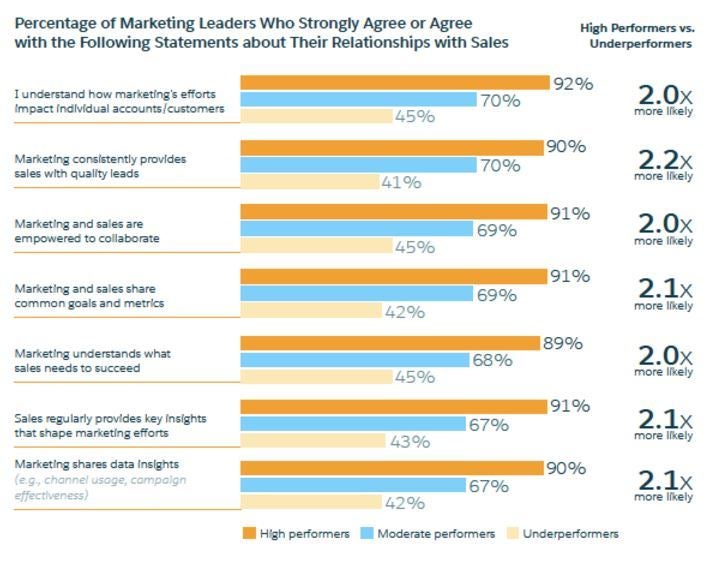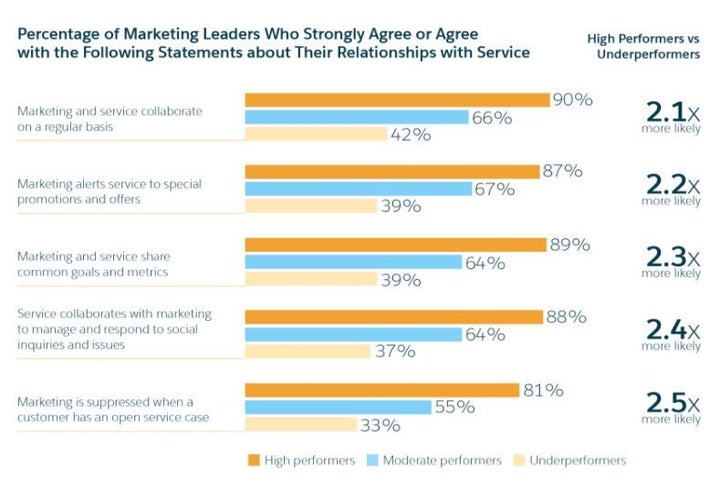If business was a rowing team, exceptional customer experience would be the coxswain. Without one, you have no guidance for how to win in today’s marketplace, and your race is over. Customer experience is the principal regatta that companies are competing in, but the rules aren’t yet carved in stone (e.g., how do we make sure all of our rowers are in cadence?). What is increasingly clear is that delivering a winning customer experience requires a departure from “business as usual” and, in particular, an new organizational mindset which puts the customer as the businesses “true-north.”
The sales team thinks they are responsible for the customer experience, service thinks service owns the customer experience and marketing thinks that it’s theirs to own. New research from Salesforce finds that nearly 65 percent of marketing leaders say their team is leading customer experience initiatives across the business. Among high-performing marketers, that figure rises to 89 percent.
The status quo isn’t cutting it for today’s customers, especially with the ease in which they are able to switch brands. More than half of them have an aggressive expectation from brands: by 2020, consumers expect companies to anticipate their needs and proactively cater to them.
In order for companies to execute this level of proactive customer journeys, they need to move beyond internally debating metrics to launching real strategies focused on data-driven customer experiences.
Marketing’s Role in the Company is Changing
Executing the ideal customer experience requires complete company alignment. There must be a willingness to evolve marketing's role as the new customer-driven efforts take shape. While marketing can’t own the entire customer experience, it is vital to understand how they can better collaborate with other business units such as sales and customer service. Research in the fourth annual “State of Marketing” report shows that marketing leaders are taking heed of these organizational challenges and looking to make the appropriate changes.
Sixty-four percent of marketing leaders believe customer journey strategies require organizational shifts—for example, redefining how sales, service, and marketing teams work together.
Top Marketing Leaders are Aligning with Sales Teams
The study finds that high-performing marketing leaders—an elite subset of 12 percent of survey respondents—are at least twice as likely as underperformers to align with sales teams across a number of facets. For starters, 91 percent of top marketers say that their marketing and sales teams share common goals and metrics, compared to just 42 percent of underperformers.

Marketing and Service Unite for a Consistent Experience
As with successful sales partnerships, high-performing marketing and service teams align
to ensure a more consistent experience for customers. Top teams are 2.2 times more likely than underperformers to alert service to special offers and promotions. And, they’re 2.5 times more likely to say they suppress marketing when there’s a known service issue.
The importance of aligning metrics between marketing and service can’t be overstated. For instance, imagine a marketing team starts a new campaign to upsell freestanding computer monitors to people who’ve purchased laptops. Marketing alerts service to a promotion around this information to sell monitors. A customer service rep is on the phone with someone, wrapping up an issue; the call has lasted one minute and fifty seconds and that rep’s success is measured on resolving calls in less than two minutes. With 10 seconds to spare, would the rep recommend a monitor or end the call? They’re not going to sell monitors because they’re trying to hit their metric of call resolution time.
This is a missed opportunity, especially because today’s customers crave personalized experiences—even if that means coughing up personal data. Among millennial consumers,
58 percent will share personal data in exchange for product recommendations that meet their needs (as will 52 percent of Gen X consumers). Business buyers also want deeper relationships; 89 percent expect companies to understand their business needs and expectations.
In rowing terms, service reps in this scenario would be on starboard and marketing would be on port. With both sides out-of-sync, this boat will inevitably flip over. This is just one way that disconnected metrics can create misalignment between departments, and ultimately result in a poor customer experience. This also goes against what customers have stated above, which is that they want brands to proactively suggest related products or services, to ease their burden of searching.
More often than not, after a sale, the customer service team is the primary group with which customers communicate. Because of that, a majority of customer service teams believe service is the biggest representation of the brand. To ensure continued loyalty and customer satisfaction, the connection between marketing and the service organization must be fluid and responsive to changing customer needs. When companies get this right, they can have significant impact on repeat purchases, upsell, cross-sell and even reduced churn rates, in recurring revenue businesses. As companies shift to become more customer-centric, it’s obvious that marketing and service should have more shared objectives than ever before.

Marketing Roles are Transforming to Reflect Customer Journeys
Beyond evolving relationships with other business units, marketing leaders are rethinking how roles within their department influence customer experience. It’s not just that Susan owns social and Ed owns email. If we’re not approaching every touchpoint with the customer as our “True North,” thinking about it from a customer journey mindset and considering how all engagements between customer and brand flow together seamlessly, then we’re already losing.
This isn’t an easy change; it’s a big shift that involves some risk in trying out new ways of working—especially the way in which teams are managed and measured. This is why you see job titles like Lifecycle Marketing Manager, Customer Success Manager, Engagement Marketing Manager, and Customer Growth and Innovation Evangelist that may not have existed five years ago. In fact, the pace of marketing overall is changing so rapidly that marketing leaders today spend an average of 34 percent of their budget on channels they didn’t know existed five years ago, but that’s a topic for another day.
Winning Customer Experience Requires the Trifecta of Teamwork
Sales, service, and marketing are clamoring to drive the customer experience—we need only to ensure they’re all heading toward the same endpoint and collaborating on how to serve the entire customer lifecycle together. Companies won’t win the customer experience regatta by executing the same old play again and again while expecting different results. We need more coxswains—strategic players that can step up and lead a concerted effort.
Organizational changes, both in the role marketing plays and the internal structure it operates with, are vital to winning customers over with your customer experience. Otherwise, you’re left with internally focused, disconnected teams, worried more about what they are doing, instead of a strategically aligned unit rowing together toward the same goal.
Note: Marketing-related data in this article comes from the fourth annual “State of Marketing” report which can be found here.
